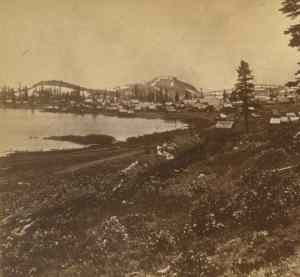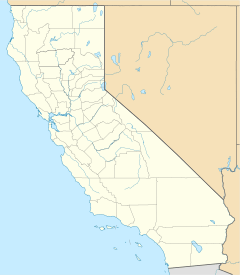Meadow Lake, Nevada County, California facts for kids
Quick facts for kids
Meadow Lake
Excelsior, Summit City
|
|
|---|---|
|
Former settlement
|
|
 |
|
| Country | |
| State | |
| County | Nevada County |
| Township | February, 1866 |
| Elevation | 7,293 ft (2,223 m) |
Meadow Lake, also known as Excelsior or Summit City, was an old mining town in Nevada County, California. It was built near the southwest shore of Meadow Lake. This lake is about 18 miles northwest of Truckee. It sits very high up, at about 7,290 feet (2,223 meters) above sea level. The lake itself is one of the highest in the Tahoe National Forest.
Contents
History of Meadow Lake
The area around Meadow Lake was first used to get water. Miners needed a lot of water for their gold claims in Northern California's Nevada County and Sierra County. This area had plenty of water. It could be collected in lakes and sent through channels to lower mining spots.
Building the Dam
In 1858, the South Yuba Canal Company built a stone wall. This wall was 900 feet (274 meters) long across a ravine. It helped form the Meadow Lake reservoir. This reservoir provided water to parts of Nevada City for many months each year. The dam was 50 feet (15 meters) tall and 15 feet (4.6 meters) wide at the top. It was made from strong granite.
Gold Discovery and Early Days
In 1860, a trapper named Henry Hartley built a cabin here. By 1863, he found small pieces of gold in granite rocks. He teamed up with John Simons and Henry Feutel. They started the "Excelsior Company" to mine for gold about a mile south of the lake. The next year, another company also claimed land nearby.
The Gold Rush Boom
The town really grew between 1865 and 1868. People hoped to find a lot of gold. In 1865, rumors spread about huge amounts of gold around the lake. One newspaper even said that tests showed $55,000 worth of gold and silver in just one ton of rock! This made many people excited.
Thousands of miners and investors rushed to the area. They claimed over a thousand spots for mining. This caused a huge boom in mining shares. Many people came from Virginia City, where they thought the local mines were running out of gold.
Summit City is Born
By June 1865, a 160-acre town was planned out. It was named Summit City. This was a planned town with streets crossing at right angles. They were named with letters in one direction and numbers in the other. There was also a town square in the middle.
By late summer, Summit City had many businesses. There were 10 stores, five lumberyards, and 10 hotels. It also had five blacksmith shops, many bars, and gambling places. There was a brewery, a book store, a cigar shop, a barbershop, and a church. The town even had a 10-piece brass band! A boat took people to dance halls at the lake's upper end.
The people of Summit City wanted a public school. They asked the local government to create a school district. Soon, the Altamont school district was formed. Summit City had more businesses than almost any other town in Nevada County. About 150 houses were built. A stagecoach ran daily to Virginia City. A Pony Express delivered mail three times a week from Nevada City. Toll roads connected the town to other areas. Famous people like Orion Clemens, Mark Twain's brother, lived there. The town had a court, a jail, and a marshal. Another town, Baltimore Town, California, also started nearby because of the gold excitement.
Winter and Rebirth
In the fall of 1865, fewer people arrived. Many residents left, and the town's population dropped to about 200. Even with heavy snow, the town was not completely cut off. Pack trains brought supplies. Granville Zachariah, known as “Zack’s Snowshoe Express,” delivered mail and newspapers. Locals enjoyed skiing and snowshoeing during the winter.
In February 1866, the county created a new township called Meadow Lake. The gold rush then started again, and Summit City grew fast. That spring, Wells Fargo opened an office, and a bank was started. More stagecoach services were added to Grass Valley. The government opened a post office in June. A daily newspaper, the Meadow Lake Morning Sun, also began.
The town asked to officially become a city. They wanted to change the name to Meadow Lake. This was to avoid confusion with another Summit City. The California government made Meadow Lake an official town on June 13, 1866. By mid-summer, the town had over 600 buildings. There were 4,000 to 5,000 residents. Six ore processing mills were working. These had been built in 15 months for over $2 million.
The Gold Problem
On June 14, 1865, a newspaper reported "very rich specimens of gold and silver." A reporter even wrote that the rock "promises to be the richest discovered on this coast, and perhaps in the world."
However, the gold in the granite rocks was often mixed with other metals. These mixtures were called sulphurets. This made it very hard to get the gold out. Some minerals in the ore stopped the mercury from working. Mercury was used to collect the gold.
At first, there were no mills to crush the rock in Meadow Lake. The rock had to be taken to Virginia City, Nevada or Nevada City, California to be crushed. The amount of gold found was much less than people expected.
The Bust
When the town started in 1865, good land lots sold for $25. By late summer, prices jumped to $800. In 1866, with more exaggerated gold reports, prices soared again. Lots sold for $1,500 to $2,500. Building continued quickly, but there wasn't enough wood.
That summer, the Excelsior Stock and Exchange Board was created. This helped people trade mining shares. One judge said about the Stock Board: "Considering that there was not at the time a mine developed, or ledge visible, in the whole district, the transaction was unique and refreshingly cool." He meant that people were trading shares for mines that didn't even exist yet!
As people learned how hard it was to get the gold, they began to wonder if the riches were just a dream. By late summer, a downturn began. People started to leave the area, often leaving their homes behind. In August, citizens voted to stop the town government. The price of land and mining stocks fell sharply.
In August 1866, only about $5,000 worth of gold was shipped from Meadow Lake. This was a tiny amount compared to what came from Virginia City. Some estimated that the $2 million invested in the mines only produced about $100,000 worth of gold.
Mark Twain's Visit
Mark Twain visited the town in 1866. He described it as: "the wildest example of speculation I have ever stumbled upon... they have built a handsome town and painted it neatly and planned long wide streets, and got ready for a rush of business, and then - jumped aboard the stage coaches and deserted it!… A bright, new, pretty town all melancholy and deserted, and yet showing not one sign of decay or dilapidation. I never saw the like before!"
That winter was very harsh, with snowdrifts 20 to 30 feet deep. The town was almost completely cut off. Still, residents had fun with snowshoe races for men and women. In the spring of 1867, few people returned. The newspaper stopped printing in November. By the summer of 1868, the town had only a hotel, two restaurants, four stores, a brewery, and six saloons. The post office was still open. The population was about 150. By 1869, most homes were empty and falling apart. The population was less than 50.
The End of the Town
In 1873, a fire started in the Excelsior Hotel. It destroyed much of the town center. After the fire, one person said the site was "dreary enough to glad the eyes of a broken Meadow Laker, whose chief occupation was to drink whiskey and curse the day he ever saw the place." When Henry Hartley died in 1892, no one lived permanently in Meadow Lake anymore.
For many years, people still hoped to find new gold. They also hoped for better ways to get gold from the sulphurets. But most of these dreams never came true. The place became known as "the Mushroom City" because it grew fast and then disappeared. By the 1940s, nothing was left of the buildings that once housed thousands of people.
Today
Meadow Lake is now part of the Tahoe National Forest. The Ranger Station is in Sierraville, California. You can still find some old mining sites, building foundations, a cemetery, and the dam. There is a campground near the lake. Not far from the old town are rocks with ancient carvings called petroglyphs. These were made by the Martis people. This site is listed on the National Register of Historic Places.


